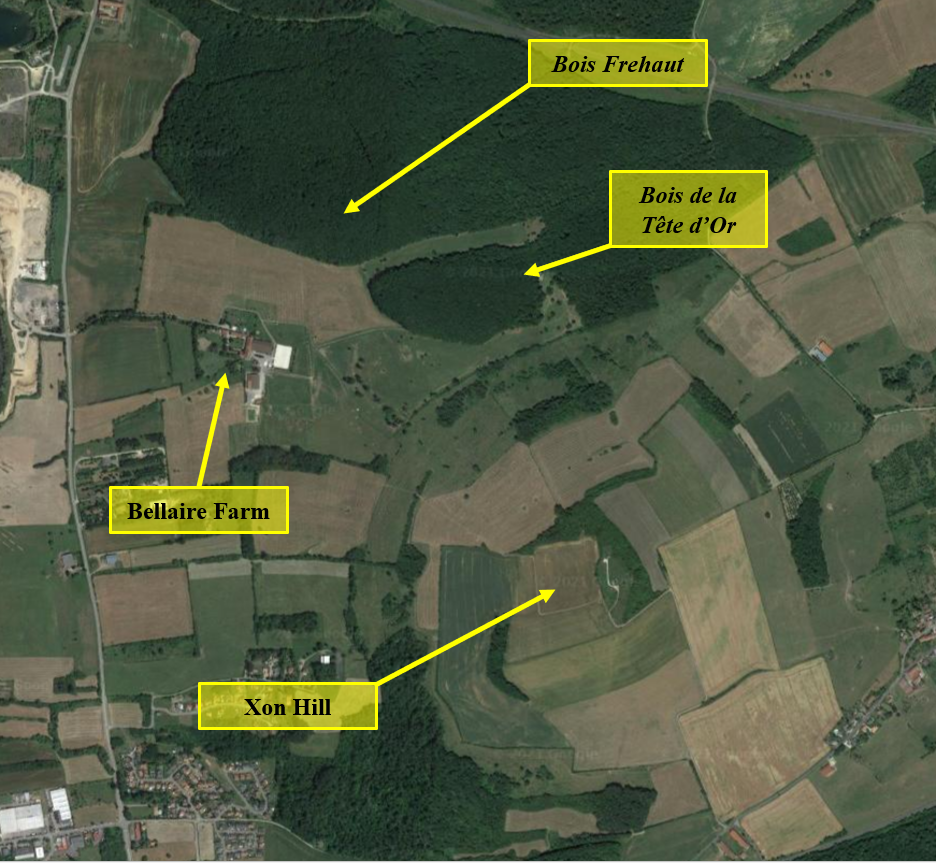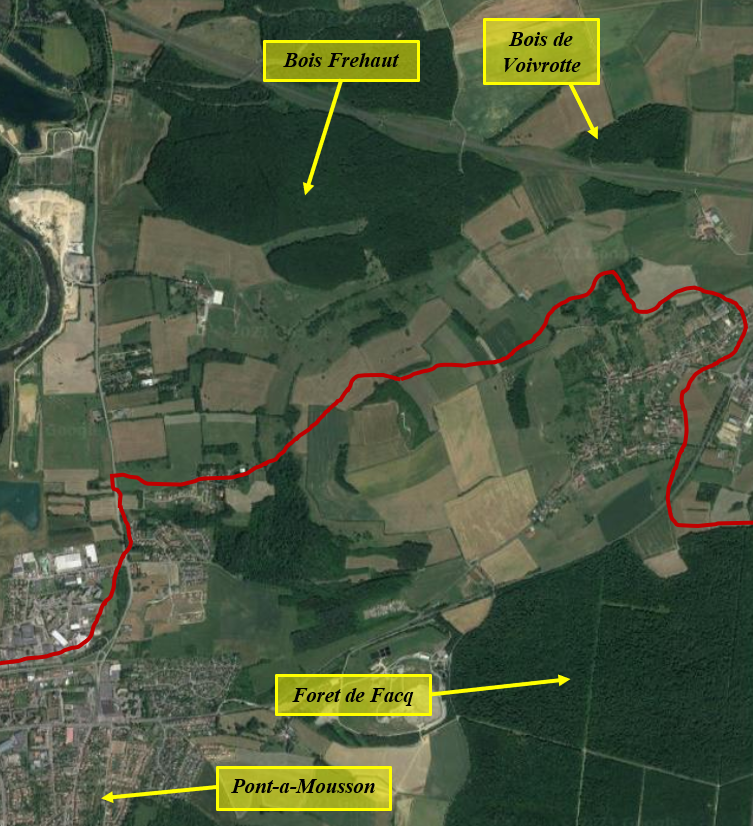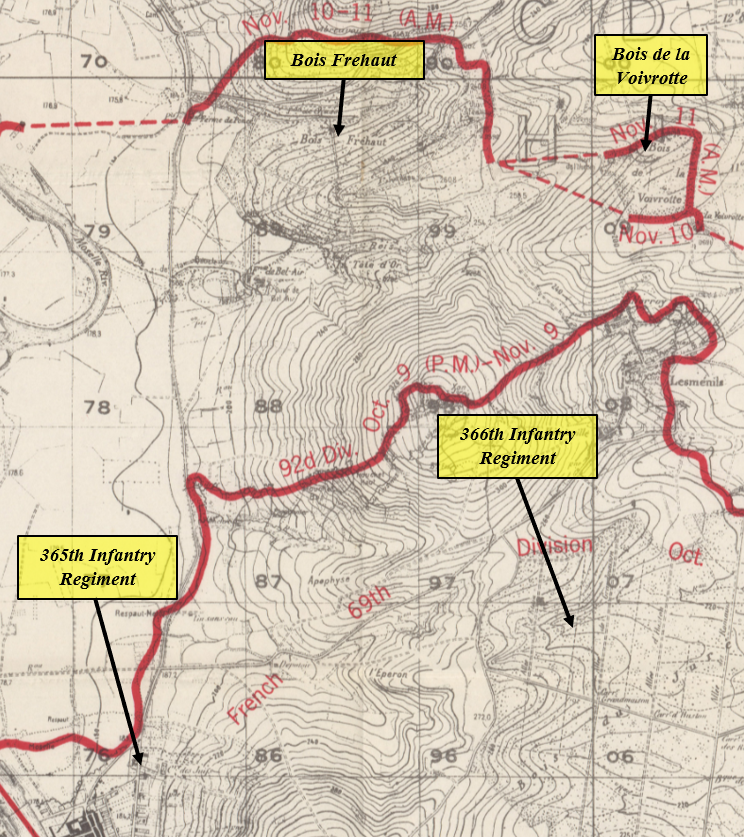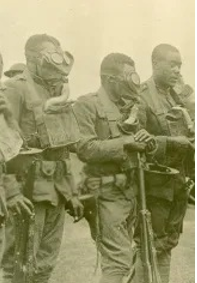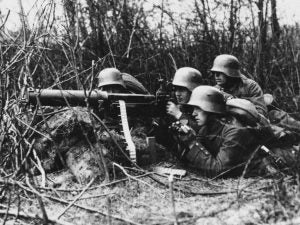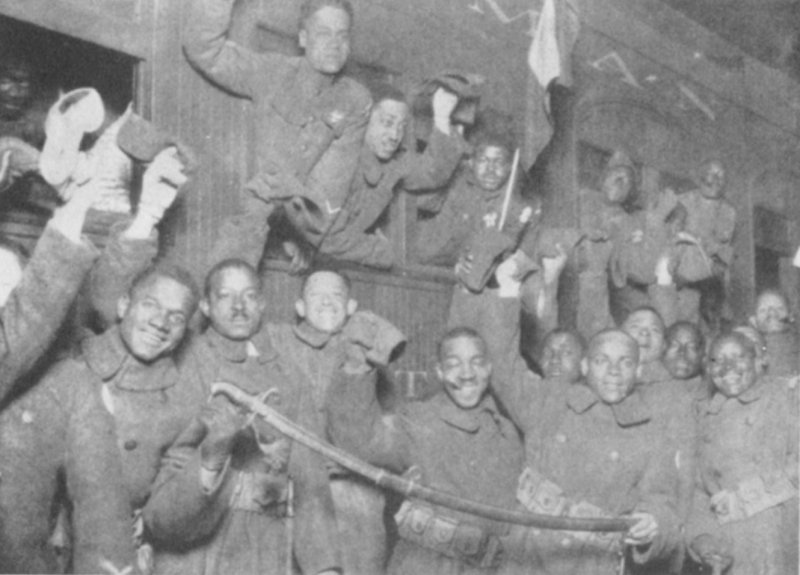William Washington Green
William Washington Green’s Personal Narrative was derived from information found in public records, military personnel files, and local/state historical association materials. Please note that the Robb Centre never fully closes the book on our servicemembers; as new information becomes available, narratives will be updated to appropriately represent the life story of each veteran.
Please contact the Robb Centre for further clarification or questions regarding content or materials.
Military Honor(s):
Distinguished Service Cross 24 March 1920
Citation: The President of the United States of America, authorized by Act of Congress, July 9, 1918, takes pleasure in presenting the Distinguished Service Cross to Captain (Infantry) William W. Green, United States Army, for extraordinary heroism in action while serving with Company H, 365th Infantry Regiment, 92d Division, A.E.F., at Bellaire Farm, France, 10 October 1918, and at the Bois Frehaut, France, 10 November 1918. On 10 October 1918, Captain Green, with utter disregard of his own personal danger, went out under enemy machine-gun and shell fire and rescued three wounded men of his company who were lying in an exposed position, administered first aid, and carried them, one at a time, to a place of comparative safety. On 10 November 1918, Captain Green led his company through wire and heavy enemy fire to its objective, when he found that the right flank of his company was exposed to enemy fire. After the arrival of two platoons and two machine guns as reinforcements, Captain Green climbed a tree in order to see over the crest of the hill behind which the enemy was advancing. In this exposed post he was subjected to heavy shrapnel and machine-gun fire, many branches of the tree being cut, but his observation enabled him so to organize his position that his command was able to repulse successfully three enemy counterattacks, thereby enabling the battalion to hold the Bois Frehaut.
Silver Star Medal
Citation: By direction of the President, under the provisions of the act of Congress approved July 9, 1918 (Bul. No. 43, W.D., 1918), Captain (Infantry) William W. Green, United States Army, is cited by the Commanding General, American Expeditionary Forces, for gallantry in action and a silver star may be placed upon the ribbon of the Victory Medals awarded him. Captain Green distinguished himself by gallantry in action while serving with Company H, 365th Infantry Regiment, 92d Division, American Expeditionary Forces, in action near Pont-a-Mousson, France, 11 November 1918, while directing his company in attack on the Boise Frehaut.
Life & Service
- Birth: 15 February 1879, Afton, VA, United States
- Place of Residence:
- Race/Ethnicity: African American
- Death: 8 April 1951 Staunton, VA, United States
- Branch: Army
- Military Rank: Captain
- Company: [H]
- Infantry Regiment: 365th
- Division: 92nd
William Washington Green was born on 15 February 1879 in Afton, Virginia to William Bolen/Bowling (1856-1936) and Margaret Loney (1858-?), the fourth of ten children; James (1872-?), Loucinda (1875-?), Maria (1877-1882), Betsy (1886-?), Rosa (1887-?), Lena (1890-?), Elnorah (1893-?), Marie (1894-?), and Carroll (1897-?). Green attended school up until the 6th grade, after which he worked odd jobs in Virginia before enlisting in the service.
Green enlisted in the United States Army’s 24th Infantry Regiment on 25 July 1898 in Virginia, serving in the Spanish-American War in 1898 Private Green was assigned to Co. I, 5 February 1899, serving in San Jose, Philippine Islands in 1900, discharging on 15 February 1902. Then-Corporal Green reenlisted on 15 February 1902, serving in the China Relief period in 1905, discharging 16 January 1909; reenlisted 16 January 1909, discharging 16 January 1912. Now with Co. D, Corporal Green reenlisted on 16 January 1912, discharging 16 January 1915 as Sergeant, reenlisted 16 January 1915, and served in the Pancho Villa Expedition with General Pershing. Sergeant Green discharged on 14 October 1917 to accept Commission; Captain Green was mustered into federal service with Co. H., 365th Infantry Regiment, 92nd Division, AEF.
Then-Captain Green and his company left Hoboken, New Jersey on 10 June 1918 aboard the U.S. Army Transport Ship Agamemnon, arriving in Brest, France on 17 June. Captain Green received the Distinguished Service Cross and Silver Star for his actions near Bellaire Farm, France on 10 October, 1918, and Bois Frehaut, France on 10 November 1918;
“The President of the United States of America, authorized by Act of Congress, July 9, 1918, takes pleasure in presenting the Distinguished Service Cross to Captain (Infantry) William W. Green, United States Army, for extraordinary heroism in action while serving with Company H, 365th Infantry Regiment, 92d Division, A.E.F., at Bellaire Farm, France, 10 October 1918, and at the Bois Frehaut, France, 10 November 1918. On 10 October 1918, Captain Green, with utter disregard of his own personal danger, went out under enemy machine-gun and shell fire and rescued three wounded men of his company who were lying in an exposed position, administered first aid, and carried them, one at a time, to a place of comparative safety. On 10 November 1918, Captain Green led his company through wire and heavy enemy fire to its objective, when he found that the right flank of his company was exposed to enemy fire. After the arrival of two platoons and two machine guns as reinforcements, Captain Green climbed a tree in order to see over the crest of the hill behind which the enemy was advancing. In this exposed post he was subjected to heavy shrapnel and machine-gun fire, many branches of the tree being cut, but his observation enabled him so to organize his position that his command was able to repulse successfully three enemy counterattacks, thereby enabling the battalion to hold the Bois Frehaut”.
Captain Green also received a Silver Star for his actions on 11 November 1918 near Pont-a-Mousson, France,
“By direction of the President, under the provisions of the act of Congress approved July 9, 1918 (Bul. No. 43, W.D., 1918), Captain (Infantry) William W. Green, United States Army, is cited by the Commanding General, American Expeditionary Forces, for gallantry in action and a silver star may be placed upon the ribbon of the Victory Medals awarded him. Captain Green distinguished himself by gallantry in action while serving with Company H, 365th Infantry Regiment, 92d Division, American Expeditionary Forces, in action near Pont-a-Mousson, France, 11 November 1918, while directing his company in attack on the Boise Frehaut”.
Captain Green and his company left Brest, France on 17 February 1919 on the U.S. Army Transport Ship Olympic, arriving in New York, New York on 24 February. Captain Green was Honorably Discharged on 26 April 1919, reenlisting on 24 July 1919; discharging to accept appointment of Warrant Officer on 28 December 1920. Green resigned his appointment on 14 January 1929, reenlisted on 15 January 1929, and retired on 23 January 1929.
Captain William Washington Green commanded Company [H], 2nd Battalion, 365th Infantry Regiment, of the 92nd Infantry Division during the First World War. During his time in the Marbache Sector, Green would twice demonstrate his capacity for courage and outstanding leadership, for which he was awarded the Distinguished Service Cross and the Silver Star Medal. What follows is the story of how he won the first of these medals.
The Marbache Sector, October 1918
8 October, 1918:
Located between the strategically important French and German cities of Nancy and Metz, respectively, the Marbache Sector was an area in which neither the Germans nor the Allies could afford to give ground. Thus, both invested heavily into their defense of this sector. Somewhat unintentionally, this meant that by 1918 most combat along this front was restricted to artillery attacks, raiding actions, and offensive patrols. However, US Military Intelligence was concerned that the understrength American Second Army, which was stationed in this area, was significantly inferior to the near 25,000 German infantry and their artillery, which was so great in quantity that it could, in one barrage, shell every three meters of the American front, and then some. Fortunately, it seemed that the German Army, facing significant supply shortages and demoralized by a series of painful defeats, were perfectly fine leaving the situation in Marbache as it was.

Men of the 367th Infantry Regiment, 92nd Division, en route to Marbache.
When the 92nd Infantry Division began moving into this area, it was observed that they were sorely understrength. Many of these soldiers lacked adequate clothing for the chilly Autumn weather and rain, and frequent movements conducted by night had left many men restless and exhausted. Further, much of the division still hadn’t seen combat, instead serving as engineers and laborers for much of the war so far. Thus, when the 92nd arrived in the Marbache Sector, it was decided that the division’s officers would need to set about ensuring proper discipline and morale amongst their troops.
9 October, 1918:
On 9 October, the 92nd Division relieved the French 69th Artillery Division in the section of the Marbache Sector East of the Moselle River. This section was home to the large Xon Hill, which gave the Americans a commanding view of the German frontline to their north in the Bois de la Tête d’Or and Bois Frehaut. This situation allowed the advance element of the 92nd Division, comprised largely of the 365th Infantry Regiment, to conduct raids into the German Frontline opposite them with accurate supporting fire. Unfortunately, these operations had to be conducted without the support of their Divisional Artillery Brigade, which was still undergoing training behind Allied lines, though the 62nd Field Artillery Brigade, 37th Division was assigned to support the 92nd.
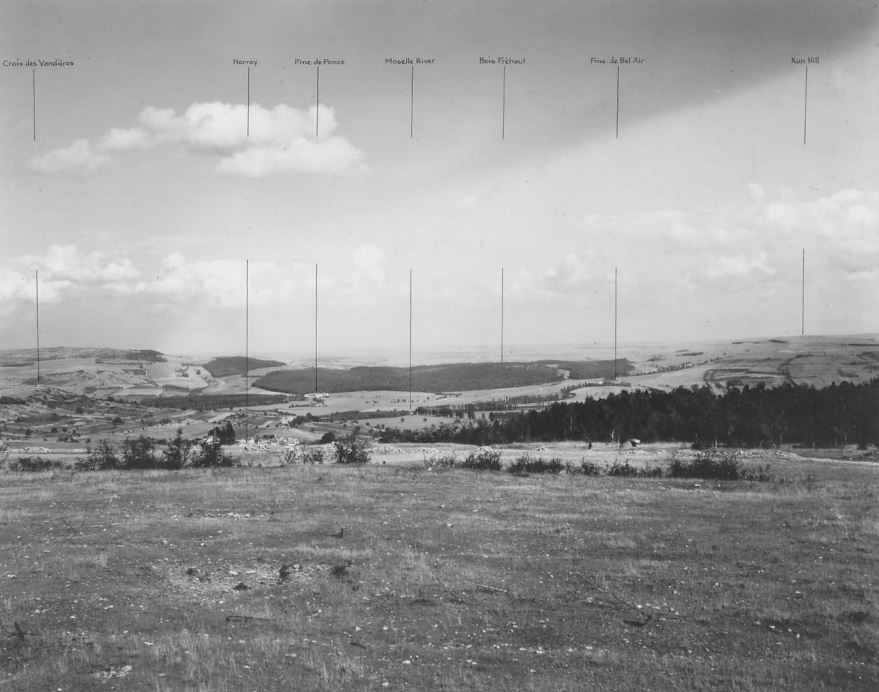
Bois Frehaut, Xon Hill, and the Bellaire Farm can all be seen on the right of this picture. The Bois de la Tête d’Or can also be seen just to the right of Bois Frehaut, behind the Bellaire Farm.
Meanwhile, beginning on 9 October the Germans began a massive series of gas attacks along the Allied lines in the Marbache Sector, lasting over the next six days. American observers estimated that the Germans likely fired some 10,000 mustard gas shells in under a week, saturating the Allied frontline and no-man’s-land with lethal poison and wounding many men. Mustard Gas’ ability to linger in an area for days after it was deployed meant that, even when the Germans weren’t actively shelling the Allied lines, the soldiers still had to be careful that they did not come into contact with contaminated soil, water, or food.
10 October, 1918:
Despite the German shells that fell all around them, the men of the 92nd Infantry Division undertook aggressive patrols almost immediately. In one such raid, conducted in the vicinity of the Bellaire farm, Captain William Green of Company [H], 365th Infantry Regiment saw three men under his command swept by the German guns hidden in the Bois de la Tête d’Or. At great personal danger, Captain Green navigated the German’s killing ground to where his wounded men lay. There, still under fire from the Germans in the hill above him, he quickly administered first aid to the wounded men before turning back to his own lines. However, as he was working alone, he could not carry more than a single man at a time. Thus, Captain Green braved the German guns three times that day, demonstrating supreme valor, concern for his men, and an utter disregard for his own safety.
For his incredible heroism during the raid at Bellaire Farm, Captain William Green received the Distinguished Service Cross. However, he would also be recognized for another heroic act performed one month later in the nearby Bois Frehaut, for which he would also receive the Silver Star Medal. This additional story is covered below.
Captain William Washington Green commanded Company [H], 2nd Battalion, 365th Infantry Regiment, of the 92nd Infantry Division during the First World War. While serving in the Marbache Sector, Captain Green repeatedly exemplified the greatest traits of an Infantry Officer. For his heroic action, he would be awarded the Distinguished Service Cross and the Silver Star Medal. What follows is the story of how he received the second of these, the Silver Star.
The Marbache Sector, November 1918
8 November, 1918:
Conditions within the Marbache Sector remained consistent through the month of October and the early days of November. Germans shells, the majority of which contained toxic gases like Mustard Gas or Diphenylchlorarsine, rained down on the American lines on an almost daily basis. Orders to maintain high levels of gas discipline went out virtually every other day. However, many men were still grievously wounded or killed. Despite this, constant raids and patrols by the 92nd Division continued through October and into November, the German reaction to which was to withdraw from their forward positions and increase bombardments. It seemed that they found the 92nd Division a most uncomfortable neighbor.
At the strategic level, the continued successes of the American First Army in the Meuse-Argonne Offensive had led many in Allied high command to suspect that the Germans would soon be forced to retreat from all present positions. The Second Army (including VI Corps, 92nd Division), which had hitherto held the line to the First Army’s West, began preparations to advance in anticipation of a German collapse. On 1 November, the Allies’ anticipation of a general withdrawal proved true. The Germans were falling back all along the front for the first time since the beginning of the war.
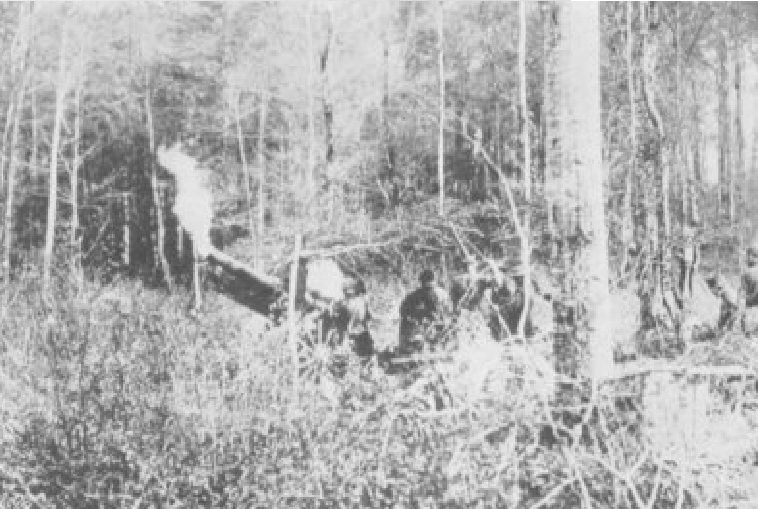
Members of the 167th Artillery, 92nd Division, conduct an artillery attack in the Marbache Sector. A mix of gas and High Explosive shells were used throughout the battle.
Over the coming week, patrols from the 92nd Division encountered little direct opposition, though the Germans had not fully withdrawn from their sector. Rather, the Germans preferred to continue their gas attacks on potential Allied staging areas so as to slow or prevent any offensive buildup. However, these attacks proved unable to prevent what was to come. Further, the American troops committed to the use of their own chemical weapons. Number 5 (phosgene) and Number 6 (a chloroformate lachrymator) Gas Shells were approved for use by the American artillery, and Number 20 (Yperite/Mustard) Gas Shells were also supplied for use with direct authorization only. Further, individual soldiers were equipped with white phosphorous rifle grenades for direct use against German machine-gun nests, and mortar crews armed with thermite and gas shells were also brought up to support the attack. The American forces were well-equipped for the coming offensive.
9 November, 1918:
Despite their preparations, the atmosphere on 9 November must has been tense. Orders came down from the High Commander of the Allied Forces, French General Ferdinand Foch, for all forces to begin offensive operations against the German Army, which was now fully committed to their retreat. The speed of their attack being of the utmost importance, the American Second Army hastened their plan. D-Day was moved up from 11 November to 10 November, and as a result much of the 9th was spent quickly moving battalions from their staging areas to jumping-off points.
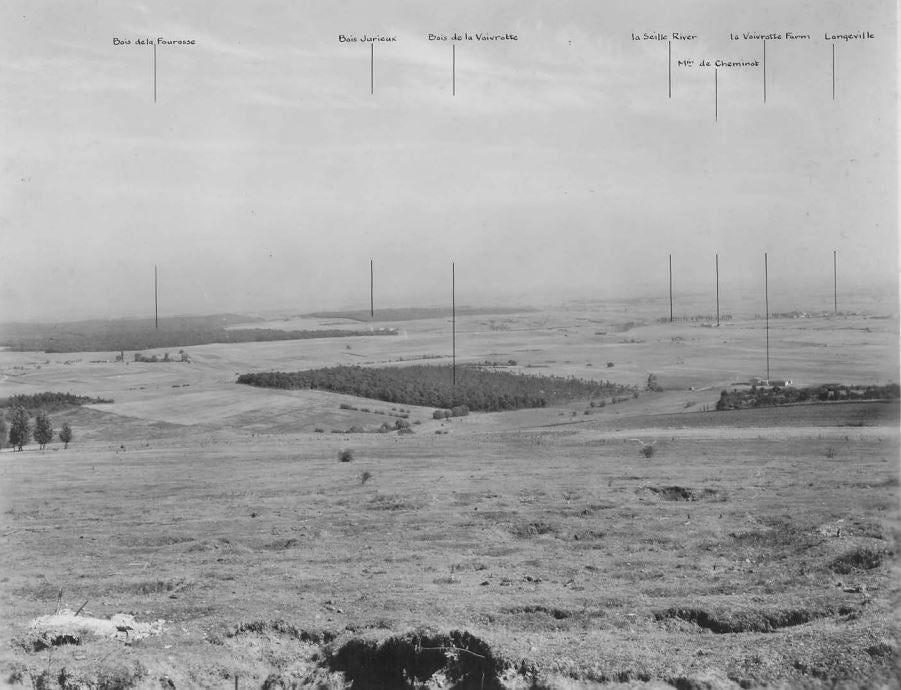
View of the Bois de la Voivrotte from Xon Hill. This small woodland would be the 366th Regiment’s primary objective during the November 10 Offensive.
For the 92nd Division, this meant that 2nd Battalion, 365th Infantry Regiment, and [D] Company, 350th Machine-Gun Battalion alongside 2 Platoons from 2nd Battalion, 366th Infantry Regiment, and [C] Company, 350th Machine-Gun Battalion were moved from their garrisons in the Foret de Facq to Pont-a-Mousson and the Northern edge of the Foret de Facq, respectively. From these positions, 2nd Battalion, 365th Regiment, and their accompanying Machine-Gun Company were to advance north to the Bois Frehaut while the platoons from the 366th Infantry moved on the smaller Bois de la Voivrotte. That night, as the soldiers settled in for whatever rest they could get, orders came in for them to begin operations at 0700 Hours (7:00 AM), 10 November, 1918.
10 November, 1918:
On the chilly morning of 10 November, the 92nd Division began their advance. By 0800 Hours (8:00 AM), the two platoons from 2nd Battalion, 366th Infantry Brigade had advanced to and were in the process of securing the Bois de la Voivrotte. Meanwhile, the battalion from the 365th Regiment was presumably still in the valley between Pont-a-Mousson and Bois Frehaut, where they had encountered heavy machine-gun fire. However, only an hour later they too had made it to Bois Frehaut, where an intense machine-gun battle broke out between the American and German forces.
It was most likely in this phase of the operation that Captain William Green again demonstrated exemplary bravery while commanding [H] Company, 365th Infantry Regiment. As the German and American guns dueled through the woody Bois Frehaut, the plentiful cover and concealment that the terrain provided had allowed Captain Green to move his unit into close-quarters combat with the Germans. By this point, all that separated his own forces from the enemy was a small hill. However, as he had advanced far ahead of the rest of 2nd Battalion, his right flank was left temporarily exposed until reinforcements could arrive. Thus, in expectation of a German counterattack, Green sought a position from which he could better observe the enemy’s movements.
He would find what he was looking for in the branches of a tree. However, while his new post did afford him a fine view of the German troops preparing for a counterattack, it also afforded them just as fine a view of him. Regardless, Green held his position even as German machine-gun fire and shrapnel trimmed the branches all around him, and directed his men with such skill and courage that they were able to repel not just one, but three German counterattacks.
For this outstanding act of leadership, William Green was awarded the Silver Star Medal. Additionally, his actions in the Bois Frehaut would also receive mention in his citation for the Distinguished Service Cross.
The following day, on the 11th Hour of November 11, 1918, the guns all along the Western Front went silent. The Great War had at last come to an end.
Green married Virginia Haeckney (1903-1940) on 12 July 1920 in Staunton, Augusta County, Virginia, they had five children together, William Jr. (1920-1978), Howard (1922-2002), Guy (1927-1980), Margaret (1930-1964) and Franklin (1933-1995). William Jr., Howard, Guy and Franklin served in the military between World War II and Korea; William Jr. as a Tuskegee Airman, Howard and Franklin in the Army, and Guy in the Navy.
Green lived in Rockfish, Virginia after the death of his wife in 1940, later, Nelson, Virginia; he died on 8 April 1951 at the University of Virginia Hospital in Charlottesville, Virginia and is buried at the Green Family Plot in Thornrose Cemetery, Staunton, Virginia.
